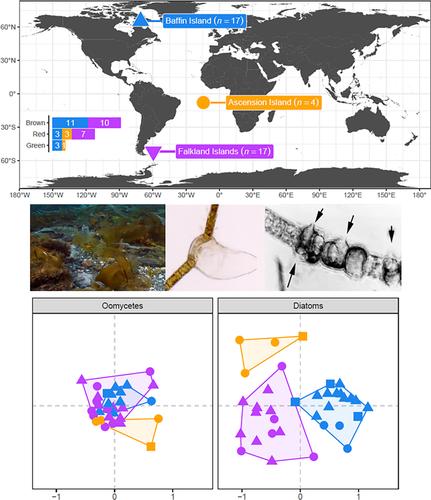当前位置:
X-MOL 学术
›
Environ. Microbiol.
›
论文详情
Our official English website, www.x-mol.net, welcomes your
feedback! (Note: you will need to create a separate account there.)
Macroalgal eukaryotic microbiome composition indicates novel phylogenetic diversity and broad host spectrum of oomycete pathogens
Environmental Microbiology ( IF 4.3 ) Pub Date : 2024-05-31 , DOI: 10.1111/1462-2920.16656 Natalia Timanikova 1 , Kyle Fletcher 1, 2, 3 , Jon-Wong Han 4 , Pieter van West 3 , Steve Woodward 1 , Gwang-Hoon Kim 4 , Frithjof C Küpper 1, 4, 5, 6 , Marius Wenzel 1
Environmental Microbiology ( IF 4.3 ) Pub Date : 2024-05-31 , DOI: 10.1111/1462-2920.16656 Natalia Timanikova 1 , Kyle Fletcher 1, 2, 3 , Jon-Wong Han 4 , Pieter van West 3 , Steve Woodward 1 , Gwang-Hoon Kim 4 , Frithjof C Küpper 1, 4, 5, 6 , Marius Wenzel 1
Affiliation

|
Seaweeds are important components of marine ecosystems with emerging potential in aquaculture and as sources of biofuel, food products and pharmacological compounds. However, an increasingly recognised threat to natural and industrial seaweed populations is infection with parasitic single‐celled eukaryotes from the relatively understudied oomycete lineage. Here we examine the eukaryomes of diverse brown, red and green marine macroalgae collected from polar (Baffin Island), cold‐temperate (Falkland Islands) and tropical (Ascension Island) locations, with a focus on oomycete and closely related diatom taxa. Using 18S rRNA gene amplicon sequencing, we show unexpected genetic and taxonomic diversity of the eukaryomes, a strong broad‐brush association between eukaryome composition and geographic location, and some evidence of association between eukaryome structure and macroalgal phylogenetic relationships (phylosymbiosis). However, the oomycete fraction of the eukaryome showed disparate patterns of diversity and structure, highlighting much weaker association with geography and no evidence of phylosymbiosis. We present several novel haplotypes of the most common oomycete Eurychasma dicksonii and report for the first time a cosmopolitan distribution and absence of host specificity of this important pathogen. This indicates rich diversity in macroalgal oomycete pathogens and highlights that these pathogens may be generalist and highly adaptable to diverse environmental conditions.
中文翻译:

巨藻真核微生物组组成表明卵菌病原体具有新的系统发育多样性和广泛的宿主谱
海藻是海洋生态系统的重要组成部分,在水产养殖方面具有新兴潜力,也是生物燃料、食品和药理化合物的来源。然而,人们日益认识到对自然和工业海藻种群的威胁是来自研究相对较少的卵菌谱系的寄生单细胞真核生物的感染。在这里,我们研究了从极地(巴芬岛)、冷温带(福克兰群岛)和热带(阿森松岛)地区收集的各种棕色、红色和绿色海洋大型藻类的真核细胞,重点关注卵菌和密切相关的硅藻类群。使用18S rRNA基因扩增子测序,我们显示了真核体意想不到的遗传和分类多样性,真核体组成和地理位置之间的强粗略关联,以及真核体结构和巨藻系统发育关系(系统共生)之间关联的一些证据。然而,真核体的卵菌部分显示出不同的多样性和结构模式,突显出与地理的关联要弱得多,并且没有系统共生的证据。我们提出了最常见卵菌的几种新单倍型广斑茅并首次报告了这种重要病原体的世界性分布和缺乏宿主特异性。这表明大型藻类卵菌病原体具有丰富的多样性,并强调这些病原体可能是通用的并且高度适应不同的环境条件。
更新日期:2024-05-31
中文翻译:

巨藻真核微生物组组成表明卵菌病原体具有新的系统发育多样性和广泛的宿主谱
海藻是海洋生态系统的重要组成部分,在水产养殖方面具有新兴潜力,也是生物燃料、食品和药理化合物的来源。然而,人们日益认识到对自然和工业海藻种群的威胁是来自研究相对较少的卵菌谱系的寄生单细胞真核生物的感染。在这里,我们研究了从极地(巴芬岛)、冷温带(福克兰群岛)和热带(阿森松岛)地区收集的各种棕色、红色和绿色海洋大型藻类的真核细胞,重点关注卵菌和密切相关的硅藻类群。使用18S rRNA基因扩增子测序,我们显示了真核体意想不到的遗传和分类多样性,真核体组成和地理位置之间的强粗略关联,以及真核体结构和巨藻系统发育关系(系统共生)之间关联的一些证据。然而,真核体的卵菌部分显示出不同的多样性和结构模式,突显出与地理的关联要弱得多,并且没有系统共生的证据。我们提出了最常见卵菌的几种新单倍型广斑茅并首次报告了这种重要病原体的世界性分布和缺乏宿主特异性。这表明大型藻类卵菌病原体具有丰富的多样性,并强调这些病原体可能是通用的并且高度适应不同的环境条件。































 京公网安备 11010802027423号
京公网安备 11010802027423号